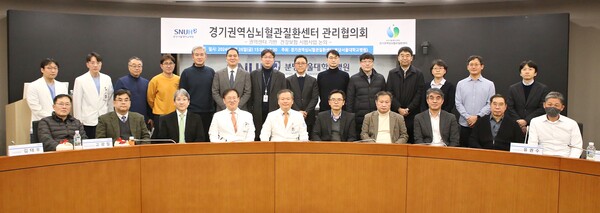Seoul National University Bundang Hospital (SNUBH) has spearheaded the launch of a network aimed at timely treatment of severe and emergency cardiocerebrovascular diseases, such as stroke and myocardial infarction, within Gyeonggi Province.

This initiative, part of the Ministry of Health and Welfare's pilot project based on the Regional Cardiocerebrovascular Center, marks a significant step forward in improving emergency medical response and patient care.
The network, which officially commenced on Feb. 26 with a meeting of participating medical institutions and emergency services, includes several notable healthcare facilities such as SNUBH, Yongin Severance Hospital, Gyeonggi Provincial Medical Center Icheon Hospital, Bundang Jesaeng Hospital, Sejong Yeoju Hospital, Uijeongbu Eulji Medical Center, Chamjoeun Hospital, Hallym University Dongtan Sacred Heart Hospital, and Hallym University Sacred Heart Hospital.
In the past, emergency medical technicians (EMTs) faced challenges in securing immediate treatment for patients suffering from acute strokes or heart attacks, often having to contact multiple hospitals to find an available emergency room, leading to critical delays.
The new network aims to mitigate these delays by enabling EMTs to quickly determine the optimal facility for treatment based on the patient's condition and location, as well as the availability and capabilities of nearby hospitals.
During the inaugural meeting, participants, including representatives from Bundang, Icheon, and Yeoju fire stations, discussed roles, cooperation strategies, and ways to strengthen response capabilities in areas particularly vulnerable to cardiovascular emergencies.
The meeting also focused on enhancing the "Stroke Hotline" system, previously established by SNUBH in collaboration with local fire departments.
"Gyeonggi Province is home to 25 percent of Korea's population, the largest single administrative region in the country, and has medical vulnerabilities that make it difficult to respond to cardiovascular diseases," SNUBH Public Affairs Director Kim Tae-woo said. "As the responsible healthcare organization for the region, we will build a system to ensure that people can receive optimal treatment safely."
Gyeonggi Province Regional Cardiocerebrovascular Center Director Bae Hee-joon also said, "Cardiocerebrovascular diseases, such as stroke, are a major health and societal problem with serious sequelae if treatment is delayed, yet the time to hospitalization has not been significantly reduced.
With the advent of an ultra-aged society, there is a need for a network of medical institutions that can provide timely treatment for severe and urgent cardiocerebrovascular diseases, Bae added.
Related articles
- SNUBH professor joins IASLC's multidisciplinary committee for global lung cancer care
- SNUBH's International Healthcare Center to set global healthcare standards
- SNUBH unveils 2023 Outcomes Book with enhanced medical transparency, quality
- SNUBH's hotline system eases anxiety of stroke patients
- SNUBH professors receive prestigious international stroke award
- Korean researchers identify genetic composition of creativity and mental disorders
- SNUBH receives presidential citation for 'Global Healthcare Achievement'
- SNUBH completes drug-induced sleep endoscopy AI data project with flying colors
- SNUBH's SMART Simulation Center offers real-world treatment experience

